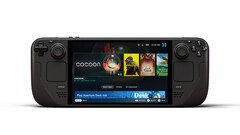
The headline addition to the new revision to Valve’s handheld console is, of course, its eye-popping OLED display. It’s got a wider colour gamut, a night-and-day improvement in contrast and brightness, and a higher refresh rate – now how about some games to make the most of all that?
Here’s three picks that are more than worth checking out; all with their own unique aesthetics and striking visuals, and all standalone adventures that you can pick up and play without being weighed down by live-service content drips or microtransactions.
1. Hi-Fi Rush
Hi-Fi Rush was a surprise hit when it came out at the start of 2023, with the developers at Tango Gameworks breaking from their previous work of horror monsters (and their then-current work of martial-arts ghosts) to put together an exceedingly stylish rhythm-action platformer game. Even putting aside how spectacle fighters are most at home on controllers, it’s a game that feels like it came straight from the mid-2000s heyday of handheld consoles, and it’s very at home on a 2023 one.
A great deal of the game’s saturday-morning-cartoon joy comes from its playful humour and loveable characters – but the delightful art style is what brings everything together. It’d be hard to imagine this particular brand of earnest fun working quite so well without the sharp outlines and bright colour palette of its visuals, and a display like the Steam Deck OLED’s is going to just make them pop!
2. Cobalt Core
Throwing in another new release, and one hot off the presses: Cobalt Core, which certainly wears its influences on its sleeve. Retro sci-fi nostalgia from FTL: Faster Than Light is blended with the roguelike deckbuilding of Slay the Spire, both indie darlings in their own right, and the two go together almost seamlessly. But it pairs these with a greater level of investment in the crew of your plucky little ship and their personalties, bringing a different angle to the emergent stories that normally come out of each run of a roguelike.
Since its launch in early November, Cobalt Core has earned itself an Overwhelmingly Positive rating on Steam – in no small part down to the adorable pixel art that brings its world to life, from the ships you fight to the zaps and explosions you throw at them. The stylised simplicity of the game’s UI keeps it legible on the Deck’s smaller screen, and the rich contrast ratio of an OLED will make every sci-fi greeble and action description stand out. You’d never have thought an attack card fit in so well with a starship control panel – whether you prefer it held there in your own two hands, or piped through an adapter (such as a JSAUX Docking Station, via Amazon) to a Star Trek-like big screen.
3. Control
Given that Alan Wake 2 is only kind of working on the Steam Deck (and only with some workarounds), you would be forgiven for thinking that developer Remedy’s previous reality-bending venture into weirdness would be too much for it too. But in spite of having been a showcase for Nvidia’s then-new RTX features when it launched, Control is still within reach of decidedly more modest hardware, like that in Valve’s handheld.
Sure, the Deck won’t be tracing many rays, but the game’s artistic vision holds up remarkably well even with the settings brought down and upscaling turned up. The glowy paranormal MacGuffins and unnaturally-colourful splatters are still plenty rich, and the brutalist concrete of the Oldest House doesn’t miss its sharp textures too much. And besides, the stark contrast between harsh light and murky shadow – an essential part of Control‘s imposing atmosphere – shows up fantastically on an OLED display like that of the new Deck.
Steam (links in game titles)
Related Articles

Matthew Lee – Magazine Writer – 7 articles published on Notebookcheck since 2023
In parallel to my studies and work in the Biomedical research, I’ve held a deep interest in technology for as long as I can remember. Over the years that’s drifted towards the more compact, efficient end of the market, seeing just how much can be squeezed out of laptops or tiny towers, as well as the design and manufacturing side of the chips we use every day. Just don’t ever ask me to code!
Matthew Lee, 2023-12- 8 (Update: 2023-12- 8)
